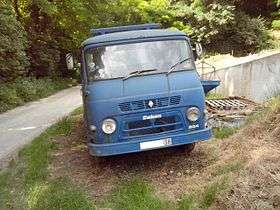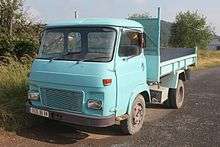Saviem Super Galion
| Saviem Super Galion | |
|---|---|
 An early-design Super Galion | |
| Overview | |
| Type | Light/medium truck |
| Manufacturer | Saviem |
| Also called |
|
| Production | 1965–1982 |
| Assembly | Blainville-sur-Orne, France |
| Body and chassis | |
| Layout | Front-engine, rear-wheel drive |
| Related | Renault Super Goélette |
| Powertrain | |
| Engine |
|
| Transmission | 4-speed manual |
| Dimensions | |
| Wheelbase |
|
| Length |
|
| Width | 78.8 in (2,002 mm) (1970) |
| Height | 90 in (2,286 mm) (1970) |
| Chronology | |
| Predecessor | Renault/Saviem Galion |
The Saviem Super Galion is a truck under 6 tonnes gross vehicle weight (GVW) produced by the French manufacturer Saviem between 1965 and 1982. It was also marketed as the Renault Super Galion.
History

In 1957, Saviem introduced the Galion, a small commercial vehicle based on previous Renault models with a 2.5-tonne payload and related to the smaller Goélette.[1][2] In 1965, as part of a renovation of the company's small vehicle range, the Saviem Super Galion was introduced along with the lighter Super Goélette.[1] The new truck had a 5.950-tonne GVW, right under the limit after which the acquisition would have been required special permits in France.[3] At the 1968 Paris Show was unveiled a new version of the Super Galion called the SG5, with changes to the suspension and gearbox.[4] The design was revised in 1968, 1969 and 1979, in-line with the Super Goélette revisions. From 21 April 1980 onwards, the truck was sold under the RVI badge.
International
Through a partnership agreement, the Super Galion was assembled by the Czech manufacturer Avia and marketed as the Avia A30.[2] It was also assembled under licence by Alfa Romeo, which sold it as the Alfa Romeos A38 and F20.[5] MAN marketed the model badging it as 475[6] and 7-90.
Technical details
Engines
By 1970, the most common engine for the SG4 was the 3.32-litre straight-four Renault-Saviem 712-01 diesel, using a MAN-sourced direct injection system and with a maximum power output of 85 bhp (63 kW) at 3,200 rpm and a torque of 149 lb·ft (202 N·m) at 2,000 rpm.[7] The first diesel engine used for the model was the 3-litre straight-four Renault-Saviem 591-01, with a Ricardo fuel injection system and a maximum power output of 75 PS (74 bhp; 55 kW) at 3,200 rpm and a torque of 180 N·m (130 lb·ft) at 2,000 rpm. The 591-01 was followed in 1968 by the similar 599-01, which simply changed the Ricardo's fuel injection for a direct fuel injection sourced by MAN. It was replaced shortly after by the 712-01.[8] The petrol engines were, at launch, the 2.1-litre Renault Étendard 671, with a maximum power output of 70 PS (69 bhp; 51 kW). In 1968, it was replaced by the 2.6-litre 817 with a power output of 78 PS (77 bhp; 57 kW) at 3,600 rpm and a torque of 20.5 kg·m (201 N·m; 148 lb·ft) at 2,000 rpm.[1]
Dimensions and variants
By 1970, the Super Galion was offered for sale with three options: bare metal chassis (for coachbuilding), cabin with only lateral panels (also for coachbuilding) and with complete bodywork. The wheelbases offered are between 2,680 mm (106 in) and 3,640 mm (143 in), the lenght is between 5,177 mm (204 in) and 6,967 mm (274 in).[1] The width is 78.8 in (2,002 mm) and the height 90 in (2,286 mm) (on the versions with complete bodywork).[7]
Suspension, transmission and related systems
The truck has an independent front suspension with coil springs and wishbones. At the rear it mounts a beam axle with leaf springs instead of the coil springs used by the similarly designed Super Goélette.[9] It has telescopic dampers on both axles. The transmission is a rear-wheel drive system with a fully synchronised 4-speed gearbox.[1][7] The drivetain has a double universal joint on the normal chassis and a triple universal joint with relay shaft on the long and extra long.[1] Brakes are drums on both axles. The steering system is a gammer worm and roller.[7]
References
- The entry incorporates text translated from the corresponding French Wikipedia entry as of 30 July 2016.
- 1 2 3 4 5 6 7 "Étude technique SG2 E "Super Goélette" et SG4 E "Super Galion"" [Technical review SG2 petrol "Super Goélette" and SG4 petrol "Super Galion"]. Revue technique automobile (in French). Boulogne-sur-Seine: Éditions techniques pour l'automobile et l'industrie (290): 3–18. June 1970. ISSN 0153-906X.
- 1 2 Greve, Jean François (2007). "Stratégies d'enterprise et action publique". In Moguen-Toursel, Marine. Firm strategies and public policy in integrated Europe (1950–1980): confrontation and learning of economic actors. Peter Lang. pp. 197–231. ISBN 978-90-5201-045-8.
- ↑ Super Goélette et Super Galion (in French), Suresnes: Saviem, 1965,
Par sa part, le Super Galion avec ses 5,950 T, demeure á la limite du tonnage au-delà duquel on ne pourrait en faire l'acquisition libre, sans licence de coordination (Meanwhile, the Super Galion, with its 5.950 tonnes, remains on the tonnage limit beyond which you could not purchase it without a coordination licence)
- ↑ "French industry loses independence". Commercial Motor. London: Temple Press. 128 (3290): 27. 4 October 1968. ISSN 0010-3063.
- ↑ Wilding, A. J. P. (10 November 1967). "Lightweights in the limelight". Commercial Motor. London: Temple Press. 126 (3242): 112–113. ISSN 0010-3063.
- ↑ Wilding, A. J. P. (8 September 1967). "MAN changes through the range at Frankfurt". Commercial Motor. London: Temple Press. 126 (3234): 43. ISSN 0010-3063.
- 1 2 3 4 Widling, Tony (14 August 1970). "Saviem SG4 5.89-ton-gross-4-wheeler". Commercial Motor. London: IPC Transport Press. 132 (3382): 37–40. ISSN 0010-3063.
- ↑ "Saviem SG2 D - Saviem SG4 D". Revue technique diesel. Boulogne-sur-Seine: Éditions techniques pour l'automobile et l'industrie (57 D): 5. ISSN 0153-906X.
- ↑ Wilding, A. J. P. (7 October 1966). "A BERLIET DOUBLE-DECKER FOR PARIS". Commercial Motor. London: Temple Press. 124 (3188): 43. ISSN 0010-3063.